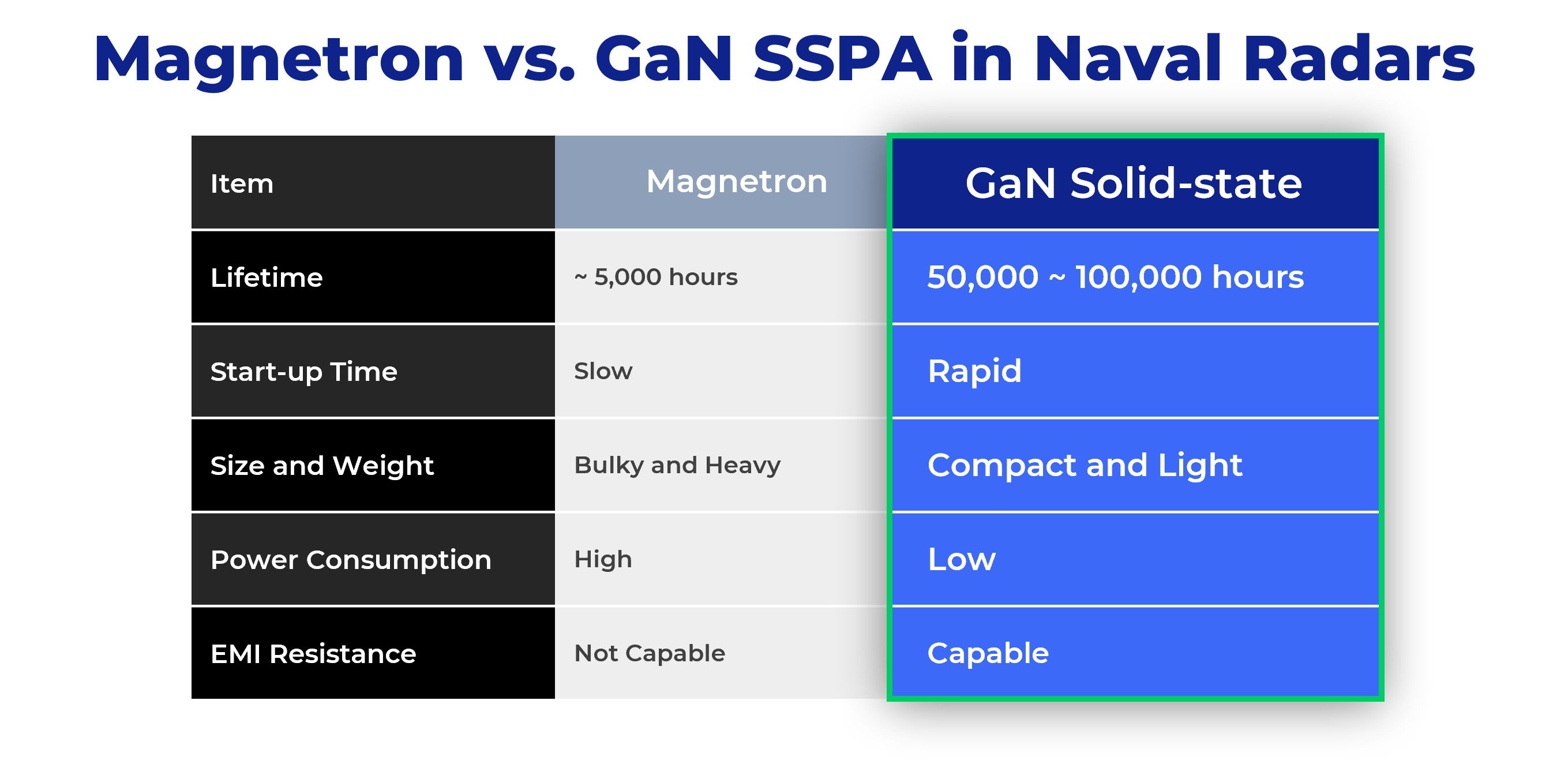Wireless Infrastructure


Marine radars are essential tools for ensuring safety and security at sea. Whether for commercial shipping, fishing, or naval defense, the ability to detect and avoid threats and obstacles quickly is crucial. Modern marine radars provide this critical capability by using advanced technology to scan the surrounding environment, identify potential dangers, and assist in navigation even in poor visibility conditions like fog, rain, or darkness.
Traditionally, marine radars have relied on magnetron-based systems. These systems have been the workhorses of the industry, known for their ability to generate high peak power pulses. However, as technology evolves, new approaches have emerged that offer significant advantages over magnetrons. One of the most promising advancements in this field is the adoption of Gallium Nitride (GaN) solid-state technology in radar systems.
Advantages of GaN Solid-State Technology over Magnetrons

1. Higher Reliability for Mission Critical Environments
GaN-based solid-state radars are inherently more reliable than magnetron systems. Magnetrons, while powerful, have a limited lifespan of 2000 to 5000 hours and require frequent maintenance or replacement due to the wear and tear of mechanical components such as cathodes and anodes. In contrast, GaN solid-state devices are more durable, with no cathodes or anodes and greater resistance to environmental stresses, often lasting up to 50,000 ~ 100,000 hours. This translates into longer operational life and reduced maintenance costs, which are critical factors in naval operations where reliability can be a matter of mission success or failure.
2. Rapid Start-Up and Instant-On Capabilities
One of the significant operational benefits of GaN solid-state radars is their ability to start up quickly and provide instant-on capabilities. Unlike magnetron systems, which often require warm-up periods before they can operate effectively, GaN-based systems can be activated instantly. This rapid response time is critical in situations where immediate radar operation is necessary, such as in emergency scenarios or when encountering unexpected threats.
3. Smaller Size and Weight
compared to traditional magnetron-based radars. This is primarily because GaN devices are able to operate at higher frequencies with greater power efficiency and thermal conductivity, thereby allowing smaller heat sinks and lighter components. This reduction in size and weight can be a significant advantage for naval vessels, where space and weight are often at a premium. Lighter radar systems can be more easily integrated into various parts of a ship or smaller vessels like patrol boats or unmanned systems, enhancing their versatility and operational flexibility.
4. Lower Power Consumption and Enhanced Efficiency
GaN-based radars are known for their superior energy efficiency compared to magnetron-based systems. GaN devices require less power to achieve the same or better performance, which is particularly beneficial for naval vessels that need to manage energy consumption carefully. Lower power consumption means less strain on a ship's power systems, which can extend operational endurance and reduce fuel costs—crucial factors in prolonged missions or in situations where energy resources are limited.
5. Enhanced Resistance to Electromagnetic Interference
In the congested electromagnetic environments typical of naval operations, the ability to resist interference is crucial. GaN-based radars offer enhanced resistance to electromagnetic interference (EMI), ensuring that they maintain high performance even in challenging conditions. This is particularly important in combat situations where electronic warfare tactics might be employed to disrupt radar systems. GaN's resilience to EMI helps ensure continuous and reliable operation, providing a tactical edge in such scenarios.
RFHIC's GaN Solid-State Solutions for State-of-the-art Naval Radars
RFHIC offers a broad range of GaN solid-state power amplifiers and transmitters for navals, operating in L-band, S-band, C-band and X-band.
Designed and manufactured with with RFHIC’s advanced GaN-on-SiC technology these products provide the perfect solution for efficient, reliable, and compact air surveillance radars.
L-Band
|
Part Number |
Type | Min Freq. [MHz] | Max Freq. [MHz] | Output Power [W] | Gain [dB] | Duty Cycle [%] |
Pulse Width [us] |
| RRK102010K-550 | Transmitter | 1,000 | 2,000 | 10,000 | 55 | 15 | 100 |
| RRP1214550-14 | Power Amplifier | 1,200 | 1,400 | 550 | 14 | 15 | 500 |
| RRP131K0-10 | Power Amplifier | 1,200 | 1,400 | 1,200 | 54 | 20 | 500 |
S-Band
|
Part Number |
Type | Min Freq. [MHz] | Max Freq. [MHz] | Output Power [W] | Gain [dB] | Duty Cycle [%] |
Pulse Width [us] |
| RRP27312K5-30 | Power Amplifier | 2,700 | 3,100 | 2,800 | 30 | 10 | 100 |
| RRT273115K-690 | Transmitter | 2,700 | 3,100 | 15,000 | 72 | 10 | 100 |
| RRP27371K5-30 | Power Amplifier | 2,700 | 3,700 | 1,500 | 30.7 | 10 | 200 |
C-Band
|
Part Number |
Type | Min Freq. [MHz] | Max Freq. [MHz] | Output Power [W] | Gain [dB] | Duty Cycle [%] |
Pulse Width [us] |
| RFMR57-CTRM-020SP-500A-SM | Transmit & Receive Module | 5,400 | 5,900 | 20 | 40 | 10 | 50 |
| RRP54591K2-42 | Power Amplifier | 5,400 | 5,900 | 1,200 | 42 | 10 | 100 |
| RRK56578K5-790 | Transmitter | 5,600 | 5,700 | 8,500 | 79 | 10 | 100 |
X-Band
|
Part Number |
Type | Min Freq. [MHz] | Max Freq. [MHz] | Output Power [W] | Gain [dB] | Duty Cycle [%] |
Pulse Width [us] |
| RRT901005K0-570 | Transmiter | 9,000 | 10,000 | 5,000 | 57 | 10 | 100 |
| RRT9397400-560 | Power Amplifier | 9,300 | 9,700 | 400 | 54 | 10 | 100 |
| RRP9596500-55 | Power Amplifier | 9,500 | 9,600 | 500 | 55 | 10 | 100 |
|
To learn more about RFHIC’s GaN Solid-State Solution for naval radars, please fill out the form below. |